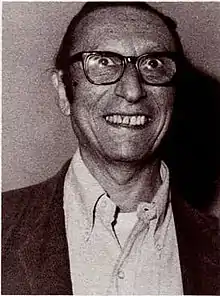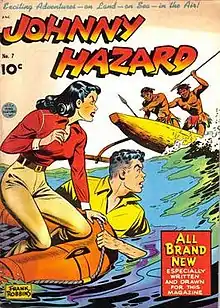Frank Robbins
Franklin Robbins (September 9, 1917[1] – November 28, 1994) was a notable American comic book and comic strip artist and writer, as well as a prominent painter whose work appeared in museums including the Whitney Museum of American Art, where one of his paintings was featured in the 1955 Whitney Annual Exhibition of American Painting.
| Frank Robbins | |
|---|---|
 Frank Robbins c. 1975 | |
| Born | Franklin Robbins September 9, 1917 Boston, Massachusetts |
| Died | November 28, 1994 (aged 77) San Miguel de Allende, Mexico |
| Nationality | American |
| Area(s) | Writer, Penciller |
Notable works | Batman Detective Comics The Invaders Johnny Hazard Superboy |
Early life
Born in Boston, Robbins was in his teens when he received a Rockefeller grant and scholarships to the Boston Museum and the National Academy of Design in New York.
Career
Robbins' early career included work as an assistant to Edward Trumbull on his NBC building murals, and creating promotional materials for RKO Pictures.
Comic strips
In 1939, the Associated Press hired Robbins to take over the aviation strip Scorchy Smith which he drew until 1944. Robbins created his Johnny Hazard strip in 1944 and worked on it for more than three decades until it ended in 1977.[2] Robbins' Johnny Hazard comic book was published by Standard Comics from August 1948 to May 1949. The Sunday strips were reprinted in a full-color volume published by the Pacific Comics Club. Other reprints were published by Pioneer Comics and Dragon Lady Press.[3]
Comic books

In 1968, Robbins began working as a writer for DC Comics. His first story for that publisher appeared in Superman's Girl Friend, Lois Lane #83 (May 1968). He became the writer of Superboy[4] as of issue #149 (July 1968) and began writing Batman and Detective Comics the following month.[5] Robbins and artist Irv Novick crafted the story which revealed the last name of Batman's butler Alfred Pennyworth in Batman #216 (Nov. 1969).[6] It was later revealed that Robbins had simply used the name created by former DC editor Whitney Ellsworth for the Batman syndicated comic strip.[7] The Robbins and Novick team was instrumental in returning Batman to the character's gothic roots as in the story "One Bullet Too Many".[8][9]
Working with editor Julius Schwartz and artists Neal Adams and Irv Novick, he would revitalize the character with a series of noteworthy stories reestablishing Batman's dark, brooding nature.[10] He introduced Jason Bard as a supporting character in Detective Comics #392 (Oct. 1969) and later wrote a series of backup stories featuring the character.[11] Man-Bat was co-created by Robbins and Neal Adams in Detective Comics #400 (June 1970).[12] Robbins and Novick created the Ten-Eyed Man in Batman #226 (Nov. 1970)[13] and the Spook in Detective Comics #434 (April 1973).[14] Robbins helped launch the Plop! title[15] and briefly drew DC's licensed version of The Shadow[16] before moving to Marvel Comics. There he launched the Invaders series with writer Roy Thomas in 1975[17] and co-created the characters Union Jack,[18] Spitfire,[19] and the Kid Commandos.[20] Other Marvel work included Captain America[21] and Ghost Rider as well as the licensed characters Human Fly and Man from Atlantis. His final new comics work was published in the black-and-white magazine The Tomb of Dracula vol. 2 #2 (Dec. 1979).[5]
Later life and death
Robbins moved to San Miguel de Allende, Mexico, and spent his final years focusing on painting. He died of a heart attack on November 28, 1994.[22]
Legacy
The Frank Robbins collection at Syracuse University has 1,090 original Johnny Hazard strips, consisting of 934 daily strips and 156 Sunday strips.[23]
Bibliography
Interior pencil work (except where noted) includes:
DC Comics
- Atom #38 (writer) (1968)
- Batman #204–207, 209–212, 214–217, 219–222, 226, 230–231, 236, 246, 249–250, 252, 254 (writer) (1968–1974)
- Detective Comics #378–383, 386, 388–436 (writer); #416, 420–421, 426, 429, 435 (writer/artist) (1968–1973)
- The Flash #180–181, 183–185 (writer) (1968–1969)
- G.I. Combat #170 (writer) (1974)
- House of Mystery #224, 226, 228, 233, 241–242, 252 (1974–1977)
- House of Secrets #125 (1974)
- Plop! #1 (writer); #4, 17 (1973–1975)
- The Shadow #5, 7–9 (1974–1975)
- Sinister House of Secret Love #3 (writer) (1972)
- Star Spangled War Stories #172–182 (Unknown Soldier) (writer) (1973–1974)
- Strange Sports Stories #1–3, 5 (writer) (1973–1974)
- Superboy #149–155, 157–164, 166–172, 181 (writer) (1968–1972)
- Superman #208, 211 (writer) (1968)
- Superman's Girl Friend, Lois Lane #83 (writer) (1968)
- Weird Mystery Tales #16 (1975)
- Weird War Tales #21, 27, 35–36 (1974–1975)
Marvel Comics
- Adventure into Fear #25–28, 31 (1974–1975)
- Captain America #182–183, 185–187, 189–192 (1975)
- Daredevil #155 (1978)
- Ghost Rider #12, 17–19 (1975–1976)
- Human Fly #5–6, 8–9, 13–14 (1978)
- Invaders #1–4, 6–9, 11–15, 17–23, 25–28, Annual #1, Giant-Size #1 (1975–1978)
- Man from Atlantis #1–7 (1978)
- Marvel Chillers #4 (Tigra) (1976)
- Marvel Premiere #28 (Legion of Monsters) (1976)
- Power Man #32–34 (1976)
- The Tomb of Dracula vol. 2 #2 (1979)
- Unknown Worlds of Science Fiction #2 (1975)
- What If...? #4 (1977)
Standard Comics
- Johnny Hazard #5–8 (1948–1949)
References
- Miller, John Jackson (June 10, 2005). "Comics Industry Birthdays". Comics Buyer's Guide. Iola, Wisconsin. Archived from the original on February 18, 2011.
- "Frank Robbins". Lambiek Comiclopedia. 2012. Archived from the original on October 14, 2012.
- Markstein, Don (2010). "Johnny Hazard". Don Markstein's Toonopedia. Archived from the original on December 15, 2013. Retrieved December 15, 2013.
- Levitz, Paul (2010). "The Silver Age 1956-1970". 75 Years of DC Comics The Art of Modern Mythmaking. Cologne, Germany: Taschen. p. 325. ISBN 9783836519816.
In 1969, Superboy...swerved radically from the complacent Super-house style once writer Frank Robbins came aboard...Overnight the comic was reinvented with realistic teen angst, natural dialogue, and a sex appeal that was only aided by the inks of good-girl artist Wally Wood.
- Frank Robbins at the Grand Comics Database
- Forbeck, Matt; Dougall, Alastair, ed. (2014). "1960s". Batman: A Visual History. London, United Kingdom: Dorling Kindersley. p. 103. ISBN 978-1465424563.
Writer Frank Robbins and artist Irv Novick revealed Alfred's last name as Pennyworth.
CS1 maint: extra text: authors list (link) - "Letters to the Batcave (letter page)" Batman 220 (March 1970)
- McAvennie, Michael; Dolan, Hannah, ed. (2010). "1960s". DC Comics Year By Year A Visual Chronicle. London, United Kingdom: Dorling Kindersley. p. 135. ISBN 978-0-7566-6742-9.
When Dick Grayson moved out of Wayne Manor to begin college, writer Frank Robbins and artist Irv Novick orchestrated a chain reaction of events that forever altered Batman's personality.
CS1 maint: extra text: authors list (link) - Robbins, Frank (w), Novick, Irv (p), Giordano, Dick (i). "One Bullet Too Many!" Batman 217 (December 1969)
- Greenberger, Robert; Manning, Matthew K. (2009). The Batman Vault: A Museum-in-a-Book with Rare Collectibles from the Batcave. Philadelphia, Pennsylvania: Running Press. p. 26. ISBN 0-7624-3663-8.
Editor Julius Schwartz had decided to darken the character's world to further distance him from the camp environment created by the 1966 ABC show. Bringing in the talented [Dennis] O'Neil as well as the innovative Frank Robbins and showcasing the art of rising star Neal Adams...Schwartz pointed Batman in a new and darker direction, a path the character still continues on to this day.
- Wells, John (May 2013). "The Master Crime-File of Jason Bard". Back Issue!. Raleigh, North Carolina: TwoMorrows Publishing (64): 39–43.
- McAvennie "1970s" in Dolan, p. 140: "Scripter Frank Robbins and artist Neal Adams [issued] 'The Challenge of the Man-Bat!'"
- McAvennie "1970s" in Dolan, p. 141: "Scripter Frank Robbins and artist Irv Novick gave Batman two handfuls of trouble in this issue."
- Manning, Matthew K. "1970s" in Dougall, p. 114: "Scripter Frank Robbins and penciller Irv Novick introduced a new villain, the green-robed Spook, in this comic."
- McAvennie "1970s" in Dolan, p. 156
- Schweier, Philip (July 2016). "Shedding Light on The Shadow". Back Issue!. Raleigh, North Carolina: TwoMorrows Publishing (89): 12–14.
- Sanderson, Peter; Gilbert, Laura, ed. (2008). "1970s". Marvel Chronicle A Year by Year History. London, United Kingdom: Dorling Kindersley. p. 170. ISBN 978-0756641238.
In 1975, [Roy] Thomas and adventure comic strip artist Frank Robbins created the Invaders.
CS1 maint: extra text: authors list (link) - Sanderson "1970s" in Gilbert (2008), p. 175: "In July [1976], Roy Thomas and artist Frank Robbins introduced the British World War I hero Union Jack."
- Sanderson "1970s" in Gilbert (2008), p. 178
- Sanderson "1970s" in Gilbert (2008), p. 186: "In May [1978], the Invaders team of writer Roy Thomas and artist Frank Robbins introduced the Kid Commandos, a World War II team of costumed teen super heroes."
- Sanderson "1970s" in Gilbert (2008), p. 168
- Aushenker, Michael (Spring 2013). "The Mexican Sunset of Frank Robbins". Comic Book Creator. Raleigh, North Carolina: TwoMorrows Publishing (1): 14–21.
- "Frank Robbins Cartoons". Syracuse University. n.d. Archived from the original on October 30, 2013.
External links
- Bautista, Arvin (October 30, 2005) "Frank Robbins" at The Neverending Battle
- Doree, Pete (October 22, 2009) "Frank Robbins" at The Bronze Age of Blogs
- Weems, Erik (2010) "Frank Robbins 1917-1994" at Art & Artifice
- Frank Robbins at Mike's Amazing World of Comics
- Frank Robbins at the Unofficial Handbook of Marvel Comic Creators
| Preceded by Leo Dorfman |
Superboy writer 1968–1972 |
Succeeded by Leo Dorfman |
| Preceded by Gardner Fox |
Batman writer 1968–1974 |
Succeeded by Len Wein |
| Preceded by Gardner Fox |
Detective Comics writer 1968–1973 |
Succeeded by Archie Goodwin |
| Preceded by Archie Goodwin |
Star Spangled War Stories writer 1973–1974 |
Succeeded by David Michelinie |
| Preceded by Michael Kaluta |
The Shadow artist 1974–1975 |
Succeeded by E. R. Cruz |
| Preceded by n/a |
The Invaders artist 1975–1978 |
Succeeded by Alan Kupperberg |
| Preceded by Sal Buscema |
Captain America artist 1974–1975 |
Succeeded by Jack Kirby |